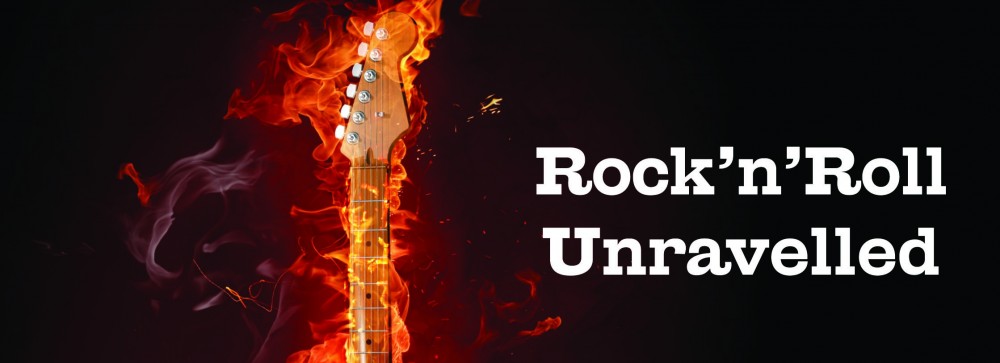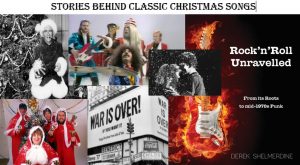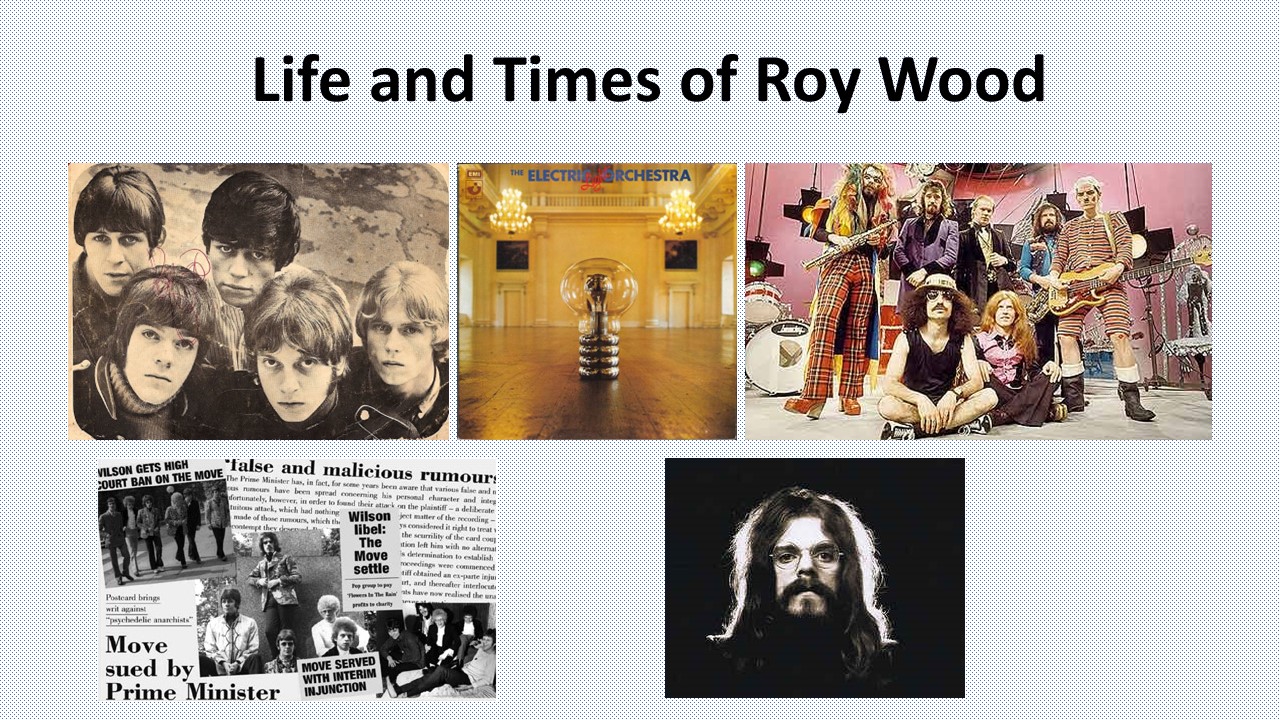Stories Behind Classic Christmas Songs
- Fairytale of New York
- Happy Xmas (War is Over)
- I Believe in Father Christmas
- I Wish it Could Be Christmas Every Day
- Merry Xmas Everybody
- Mistletoe and Wine
- White Christmas
FAIRYTALE OF NEW YORK
The Pogues released Fairytale of New York in December 1987 (UK). It featured guest singer Kirsty MacColl, was written by band members Shane MacGowan and Jem Finer, and produced by Steve Lillywhite.
It peaked at #2, held from the top spot by the Pet Shop Boys’ Always on My Mind.
The band also has another Christmas tie, lead singer Shane MacGowan was born in Kent, Ireland on 25 December 1957.
The song came about after Elvis Costello wagered Shane MacGowan that he couldn’t write a Christmas duet with his (Costello’s) future wife Cait O’Riordan, who was the band’s bass player at the time. Elvis Costello co-produced their 1985 album, Rum Sodomy and the Lash.
Jem Finer had already written an abandoned Christmas song and the melody was taken for this new song. The lyrics went through a number of permutations, during which a version with Cait O’Riordan was recorded by Elvis Costello.
Time rolled on and they met Steve Lillywhite when he was brought in to produce their next album, If I Should fall From Grace with God. By then Cait O’Riordan had parted company with the band. She left around October 1986. Steve Lillywhite was married to Kirsty MacColl, the song was recorded again and this was the version used for the 1987 release.
The song title came from the novel A Fairy Tale of New York, by JP Donleavy. A book that Jem Finer happened to be reading at the time.
HAPPY XMAS (WAR IS OVER)
THE BEATLES AT CHRISTMAS
It wouldn’t be Christmas without a Beatles song. The Beatles may not have had specific Christmas songs but they scored four Christmas #1s: I Want to Hold Your Hand – 1963, I Feel Fine – 1964, Day Tripper/We Can Work It Out – 1965, and Hello Goodbye – 1967. Their final single released in 1966, Yellow Submarine c/w Eleanor Rigby, entered the UK chart on 11 August. The was to be the last in a run of 11 consecutive UK #1s. Their next hit single Penny Lane/Strawberry Fields Forever entered the UK chart on 23 February 1967 but only managed to reach #2.
The Beatles did release Christmas singles but only as flexi singles to members of their Fan Club. They released a flexi single every Christmas from 1963 to 1969. The also staged Christmas shows in London in 1963 and 1964. On BBC Radio’s Light Service they appeared on Saturday Club on 21 December 1963. In this show they did come close to a Christmas song with a performance of their Crimble Medley.
By Christmas 1963 the Beatles were sweeping all before them. They released their first UK single, Love Me Do, in October 1962. In December 1963 they appeared on the highly prestigious Morecambe and Wise Show and all four Beatles appeared on Juke Box Jury panel. They scored their first UK Christmas #1 with I Want to Hold Your Hand. It held the #1 position for 5 weeks and was the first-ever single to attract over 1-million advance orders.
It was also Christmas 1963 that The Beatles cracked America. The American arm of Capitol Records finally decided to release the Fab Four’s singles in America. (Capitol Records in Canada had been releasing Beatles singles throughout 1963.) I Want to Hold Your Hand held the #1 position for 7 weeks. On 9 February 1964 they made their first appearance on the Ed Sullivan Show. It was watched by 73 million people and instigated the British Invasion. For the next two years British acts dominated the American music scene.
The mood of Christmas 1963 was captured by Dora Bryan’s All I Want for Christmas Is a Beatle. Born in Lancashire in 1924, Dora Bryan was a star of stage and screen, including the movies: The Blue Lamp, which inspired the TV cop drama Dixon of Dock Green; Carry on Sergeant, the first Carry On movie; and Taste of Honey, one of the classics of the 1960s kitchen sink realism movies.
After the Beatle went their separate ways they all released festive records: Paul McCartney – Wonderful Christmastime 1979; George Harrison – Ding Dong 1974; Ringo Starr – opted for a whole album of Christmas songs, I Wanna Be Santa Clause 1999, which included the inevitable cover of White Christmas; John & Yoko and the Plastic Ono Band – Happy Xmas (War is Over).
JOHN LENNON
This is the story of… Happy Xmas (War is Over).
John Lennon’s “War is over if you want it” poster campaign started on 15 December 1969, two years before the single was released.
John and Yoko launched an international peace campaign with posters proclaiming, “War is over! … If you want it … Happy Christmas from John & Yoko”. It kicked off with the Peace for Christmas benefit concert at London’s Lyceum Ballroom. This was the British debut of the Plastic Ono Band. It was the first time that John Lennon and George Harrison had shared a stage since 1966. The lineup included, George Harrison, Eric Clapton, Klaus Voormann, Billy Preston and Delaney & Bonnie. Keith Moon joined them onstage and gave one of the floor toms a good hammering. They played extended versions of 2 songs, Cold Turkey and Don’t Worry Kyoko, both of which appear on Lennon’s album Sometime in New York City.
The following day John Lennon and Yoko flew to Canada, where they stayed until 23 December. They put up posters in Toronto to coincided with War is Over posters in twelve cities worldwide. This marked the end of their protest activities for the next two years.
On 1 December 1971, John & Yoko and the Plastic Ono Band released Happy Xmas (War is Over) in America. Written by John & Yoko and produced by John & Yoko and Phil Spector, it also featured the Harlem Community Choir. This American release failed to trouble the Billboard Top-40. In fact, the song has never scored a top-40 position in America.
John and Yoko were joining in the anti-war protests, against the Vietnam War. By the end of 1967, the War was very unpopular in America. The Army and Johnson Administration were still talking up the War and claiming to be defeating the communists in Vietnam. However, all that changed when the North launched its Tet Offensive at the end of January 1968. This came in the form of multiple, simultaneous attacks on American positions in South Vietnam. The American and South Vietnamese forces eventually contained the attacks but it marked the turning point in the War.
Peace talks began 10 May 1968. The Paris Peace Accords were signed on 27 January 1973. This was when America’s war in Vietnam was over. The communist North Vietnamese were still fighting for a united Vietnam. Their victory came when Saigon fell to the communists on 30 April 1975.
John Lennon and Phil Spector both suggest that the melody for Happy Xmas (War is Over) is based on a previous Phil Spector song, I Love How You Love Me by the Paris Sisters. It is often attributed to the traditional English ballad Skewball, which has been recorded as Stewball, with a well-known version by Peter, Paul & Mary.
Happy Xmas (War is Over) was released in Britain in 1972, it peaked at #4. Publishing wrangles meant that the UK release was delayed. It has been released subsequently in the UK: 1975 – #48, 1980 – #2, 1981 – #28, 1982 – #56, with additional releases after 2000.
I BELIEVE IN FATHER CHRISTMAS
In 1975 I Believe in Father Christmas released was a UK Christmas hit for Greg Lake. It gave him a UK #2, held off the top spot by Queen’s Bohemian Rhapsody, which spent nine weeks at #1.
Greg Lake and Pete Sinfield wrote and produced the song. Pete Sinfield had known Lake for a while and was the lyricist at King Crimson.
Bass player Greg Lake had an impressive background in bands including, The Gods, King Crimson and Emerson Lake & Palmer.
The Gods was formed 1965 by: Ken Hensley – keyboards, who went on to form Uriah Heep, Mick Taylor – guitar, who replaced Brian Jones in the Rolling Stones and John Glascock – bass, with Chicken Shack and Jethro Tull.
I Believe in Father Christmas was based on Prokofiev’s Lieutenant Kije Suite, written for the 1933 Russian movie of the same name. When the movie was released in America in 1934, the title was changed to The Czar Wants to Sleep.
Greg Lake wrote the song as a protest against commercialism at Christmas. The wonderful last line is the foreboding, “The Christmas we get we deserve.”
I WISH IT COULD BE CHRISTMAS EVERY DAY
In early November 1973 Wizzard released I Wish It Could Be Christmas Every Day on Warner Brothers (UK). At the end of November, the single was also released on Harvest. The band was in the process of changing record labels and was moving from Harvest to Warner Brothers.
The song was written and produced by Roy Wood. Vocal backing is credited to “The Suedettes, Plus the Stockland Green Bilateral School First Year Choir. Add. Noises Miss Snob & Class 3C”.
The single peaked at #4, losing out to Slade’s Merry Xmas Everybody.
Roy Wood was a founding member of the Move in early 1966. He formed Electric Light Orchestra alongside the Move in early 1970. His vision for ELO was to pick up where the Beatles’ Sgt Pepper left off. After just one eponymous album, aka No Answer, he left ELO to form Wizzard.
I Wish It Could Be Christmas Every Day was recorded in August. In order to build up a Christmas atmosphere he decorated the office with Christmas decorations, turned the aircon down to Arctic and sent his roadies out to buy electric fans. The resulting temperature was so low that the band played in overcoats.
When the rivals for the Christmas #1, Wizzard and Slade, appeared on TV in Top of the Pops they engaged in a custard pie fight.
It’s interesting to ponder on what might have happened if Wizzard had released their single on just one label. It might have been that the focussed marketing from a single record company might have secured them the coveted #1 Christmas spot.
Both singles have been re-released against each other eleven times up to 2016: 1984 and a run from 2007 to 2016. Wizzard has secured the higher chart position on 10 occasions. Slade won in 2009, with Slade reaching #35 and Wizzard #45.
MERRY XMAS EVERYBODY
7 December 1973, Slade released Merry Xmas Everybody (UK), written by band members Noddy Holder and Jim Lea, and produced by Chas Chandler. (Chas Chandler had previously played bass guitar with the Animals and, following that, managed Jimi Hendrix.) The single went straight into the charts at #1 and spent five weeks on the top spot. It was to be their last UK #1. It sold 500,000 copies within the first week of its release. Slade have released the song as a single in every decade since 1973.
Famously, Wizzard released I Wish it Could be Christmas Every Day in 1973, it peaked at #4.
In the early summer of 1966, singer Noddy Holder was the last person to join the lineup of the ‘N Betweens. At the end of the year, the N’ Betweens released the single You Better Run. Felix Cavaliere and Eddie Brigati of the Young Rascals wrote the song and it was an American hit for them in the summer of 1966. By the beginning of 1969 they had changed their name to Ambrose Slade. Later that year they released an album and single and teamed up with their new manager, Chas Chandler. It was at Chandler’s suggestion that the band dropped the “Ambrose” and became “Slade”.
It was also Chandler’s suggestion in 1973 that they should write Christmas song. Jim Lea came up with the idea for the song. He remembered that back in the N’ Betweens days in 1967, Noddy had written Buy Me A Rocking Chair, his first solo work. They used the melody from Rocking Chair for the chorus and added Lea’s melody for the verse. Noddy wrote the lyrics. He wanted to reflect a typical British family Christmas.
In 1973 times were hard. Inflation grew to 10% and by end of 1974 was at 19%. There were constant strikes, with the three-day week starting on New Year’s Day. Mortgage rates were at 8.5% and rising. (They peaked at around 15%.) Income tax was 75% and rising. Noddy felt the great British public needed cheering up. He felt that there was a lot to look forward to and as he says in the song, “Look to the future now, it’s only just begun.”
They recorded the song in July, at the Record Plant in New York. Parts were recorded in a corridor in order to achieve a greater echo effect.
In 2015 it was estimated that the song produces £500,000 royalties every year. In 2009 PRS for Music, the performing rights people, estimated that 42% of the world’s population could have heard the song!
MISTLETOE AND WINE
Cliff Richard scored his first Christmas #1 with Mistletoe and Wine in 1988. Written by Leslie Stewart and Jeremy Paul, Cliff produced the single himself.
The song started life in the 1975 musical, Scraps, which was adapted from Hans Christian Anderson’s story, The Little Match Girl. Scraps debuted at the Orange Tree Theatre in Richmond, West London, in December 1976.
Mistletoe and Wine was originally written to sound like a carol, sung ironically. Essentially the tale of a little girl slung out into the snow by the wicked middle classes. A look at the contrasting worlds of the haves and have-nots.
In 1987 it was adapted for television by HTV. A Christmas musical, set in Victorian times, The Little Match Girl starred Roger Daltrey, Twiggy, Paul Daneman and Jimmy Jewel.
Cliff Richard liked song but changed the lyrics to reflect a more religious theme.
WHITE CHRISTMAS
Irving Berlin wrote White Christmas in 1940 and since then it has sold over 50 million copies.
Bing Crosby performed the song for the first time on his NBC radio show, Kraft Music Hall, on Christmas Day 1941. On 29 May 1942, he reputedly recorded the song in just 18 minutes. In July White Christmas was released as a 6-single soundtrack (US) for the movie Holiday Inn. On 31 October it reached #1 on the National List of Retail Records chart, the predecessor to Billboard and Cashbox, where it remained for 11 weeks.
Original 1942 version of White Christmas
On 19 March 1947 Bing Crosby re-recorded White Christmas because the master was damaged from the frequent use it was being put to cope with the song’s popularity. This is the version which is most frequently heard on the radio and Christmas compilation album releases.
The movie White Christmas was released in 1954.
It is one of the most covered songs of all time. The website Second Hand Songs lists 1,224 covers. These covers include: Elvis Presley, on his 1957 Elvis’s Christmas Album; Big Maybelle, who released the original version of the Jerry Lee Lewis classic Whole Lotta Shakin’ Goin’ On, covered it in 1958; the singing pigs Pinky & Perky in 1961; The Beach Boys in 1964; The Temptations in 1970 and Stiff Little Fingers in 1980. London football club Tottenham Hotspur released it in 1981 and the King of British Christmas singles, Cliff Richard, included it on his 1991 album Together with Cliff Richard. Phil Spector’s legendary 1963 Christmas album, A Christmas Gift for You, gave the song a wall of sound flavour with the lead vocal taken by Darlene Love.


